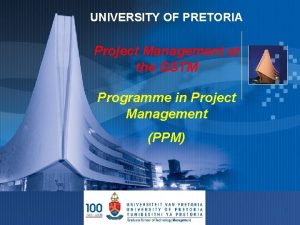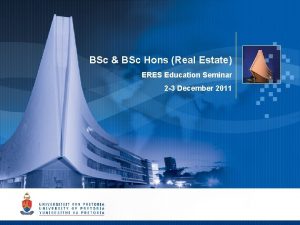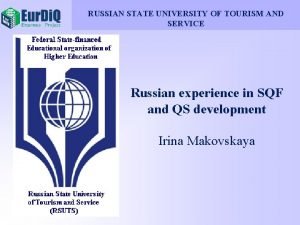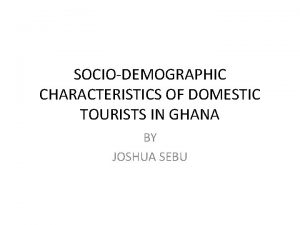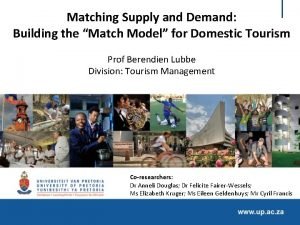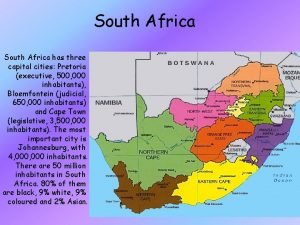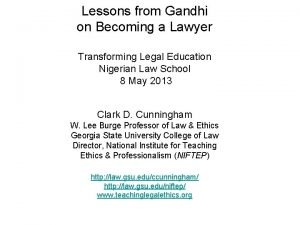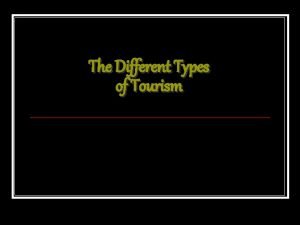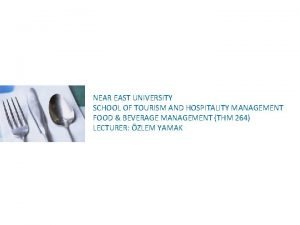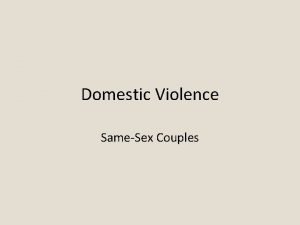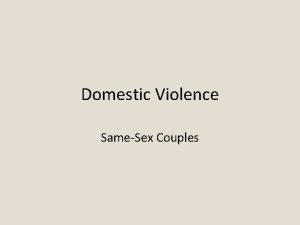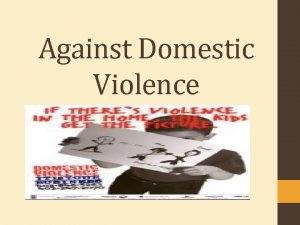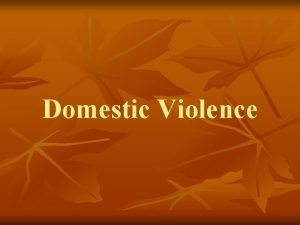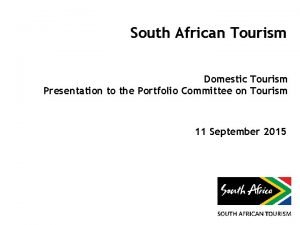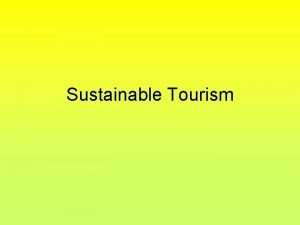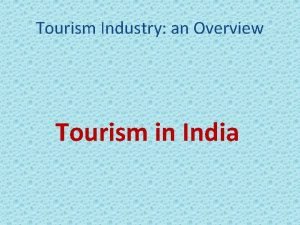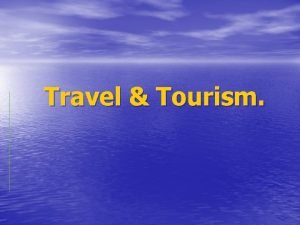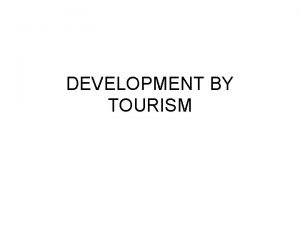University of Pretoria THE STATE OF DOMESTIC TOURISM
















- Slides: 16

University of Pretoria THE STATE OF DOMESTIC TOURISM IN SOUTH AFRICA: CHALLENGES AND OPPORTUNITIES 30 March 2015 Prof Berendien Lubbe Division: Tourism Management berendien. lubbe@up. ac. za

Overview • • What domestic tourism is Why it is important How we are performing How we compare How we travel Our challenges Our opportunities 2

What is domestic tourism? • Domestic Tourism The tourism of resident visitors within the economic territory of the country of reference (Stats. SA). • Domestic Tourist Residents of one country travelling only within that country, Ø Outside usual environment Ø Not remunerated within the place visited • Domestic Travel & Tourism Spending – Spending within a country by that country’s residents for both business and leisure trips 3

Why is domestic tourism important? • Cushions effect of global market volatility, bringing stability & predictability in the industry • Lessens troughs in seasonality • Keeps spending money within home country • Geographic spread of tourists beyond main city areas • Year-round economic growth • Increased employment (direct and indirect) - poverty alleviation • Tourism culture creates responsibility for tourism protection within local communities • Generation of pride and ambassadorship for country • Not as vulnerable to problems arising from international airline schedules, changing international tastes, perceived security threats • Greater loyalty towards destination (Butler, 2012; Okello et al. , 2012; Mendiratha, 2011; Cornellisen, 2005; Rogerson & Lisa; 2005) 4

How are we doing? South Africa: Tourism Spending Domestic vs Foreign 100% 90% 80% 70% 60% 50% 40% 30% 20% 10% 0% 2009 2010 2011 Domestic 2012 Foreign Source: WTTC, 2015 2013 2014 2015 2025 Domestic Tourism growth (Real 2014 Prices) 5

How do we compare? China: Tourism Spending Domestic vs Foreign South Africa: Tourism Spending Domestic vs Foreign 100% 90% 80% 70% 60% 50% 40% 30% 20% 10% 0% 0% 2009 2010 Domestic 2011 Foreign 2012 2013 2014 2015 2025 Domestic Tourism growth (Real 2014 Prices) 2009 Domestic 2011 Foreign 2012 2013 2014 2015 2025 Domestic Tourism growth (Real 2014 Prices) Kenya: Tourism Spending Domestic vs Foreign Zimbabwe: Tourism Spending Domestic vs Foreign 100% 90% 80% 70% 60% 50% 40% 30% 20% 10% 0% 2010 0% 2009 2010 Domestic 2011 Foreign 2012 2013 2014 2015 2025 Domestic Tourism growth (Real 2014 Prices) Source: WTTC, 2015 2009 2010 Domestic 2011 Foreign 2012 2013 2014 2015 2025 Domestic Tourism growth (Real 2014 Prices) 6

How do we travel? Key Metrics Annual 2007 35, 9 Million 2008 32, 9 Million VFR: 68%, VFR: 71%, By Holiday: 56%, Holiday: 16%, Number purpose Business: 7%, Business: 5%, Religious: 7%, Religious: 5%, of Trips Medical: 1 % Medical: 2 % Total Annual R 20. 0 Billion R 25, 8 Billion spend 2009 30, 3 Million 2010 26. 4 Million 2012 2013 25, 4 Million 25, 2 Million VFR: 76%, VFR: 74%, VFR: 73%, VFR: 72%, Holiday: 12%, Holiday: 13%, Holiday: 15%, Holiday: 12%, Business: 5%, Religious: 5%, Religious: 6%, Religious: 8%, Medical: 1 % VFR: 70%, Holiday: 12%, Business: 8%, Religious: 7%, Medical: 1 % R 28, 8 Billion 29, 7 Million 2011 R 21, 1 Billion R 20, 2 Billion R 21, 8 Billion R 24, 3 Billion VFR: 45%, VFR: 59%, VFR: 51%, VFR: 52%, VFR: 47%, By Holiday: 37%, Holiday: 39%, Holiday: 22%, Holiday: 31%, Holiday: 23%, Holiday: 26%, purpose Business: 14%, Business: 12%, Business: 17%, Business: 14%, Business: 14% Business: 17%, Business: 19%, Religious: 3%, Religious: 2%, Religious: 3%, Religious: n/a%, Religious: n/a, Medical: 0 % Medical: 2 % Medical: 1 % Medical: 0% Medical: n/a% Spend Average R 550/ Trip Spend per Trip R 780/Trip R 730/Trip R 710/Trip R 780/Trip R 850/Trip R 980/Trip (Source: SA Tourism; Statssa) 7

Percentage spend on most recent overnight trips by population group at province of destination, Jan – Dec 2013 Source: Stats. SA Domestic Tourism Survey, 2013 8

What are our challenges? • Research focus • Economic impediments – Affordability – Loss of income – informal sector) • Social impediments – – • • Lack of knowledge Lack of awareness of activities (e. g. KNP) Socialisation patterns (Butler, 2012) Lack feeling of “belonging” in many recreational spaces Tourism capacity at local government level Limited resources in domestic tourism Infrastructure capacity Matching supply and demand in all regions 9

Are we using our opportunities? We have gained recognition………… China South Africa (DTGS) • During 2009 Recession • “Tourism belongs to all“ – Tourism authorities launched series of stimulus plans to boost domestic tourism • Promotion of rural tourism & tourism coupons • Introduction of “Golden Weeks” – National days & Festivals – Stimulate a tourism culture (SAT) • Sho’t Left campaign • First-time travellers FAQ (SAT) • “Fun Bus” – Industry innovations for new travellers • Tour Operator packages (Mendiratta, 2011; Rogerson & Lisa, 2005; Lang, liu & Ki, 2013 ) 10

……but we can always do more • Recognise the value of the “Diaspora” VFR market? • Adding the “Diaspora tourist” as sub-segment of domestic tourism (Scheyvens, 2007) Nationals from a country who live overseas - the diaspora – but who return home for short holidays (same characteristics as the domestic tourist): – – Tendency to travel to places that foreign tourists do not go Attend important social and cultural events Distinct from international visitors Can make significant contributions to development of their country 11

• Match tourism supply & demand – One size fits all is not the solution – Recognise that: 1. Domestic market segments have different needs 2. Product offerings in different regions meets these needs to a greater or lesser extent 3. Each tourism region (stakeholders) should cohesively develop their product offerings to meet the needs of the different market segments 12

Match Model (2013) 13

14

“…leisure travel is no longer…. the exclusive prerogative of the upper classes. . …it extends beyond the growing middle class to include the participation in leisure travel of the lower middle classes. ” (Rogerson & Lisa, 2007: 91) 15

Thank you 16
 Project management course university of pretoria
Project management course university of pretoria University of pretoria powerpoint template
University of pretoria powerpoint template Russian state university of tourism and service
Russian state university of tourism and service Domestic tourism in ghana
Domestic tourism in ghana Supply and demand matching
Supply and demand matching Exhibition booth cape town
Exhibition booth cape town Three capital of south africa
Three capital of south africa Abdulla sheth
Abdulla sheth St georges hotel pretoria
St georges hotel pretoria Daniel adams pretoria
Daniel adams pretoria Mass tourism vs alternative tourism
Mass tourism vs alternative tourism Classical brigade system
Classical brigade system Hình ảnh bộ gõ cơ thể búng tay
Hình ảnh bộ gõ cơ thể búng tay Frameset trong html5
Frameset trong html5 Bổ thể
Bổ thể Tỉ lệ cơ thể trẻ em
Tỉ lệ cơ thể trẻ em Chó sói
Chó sói
